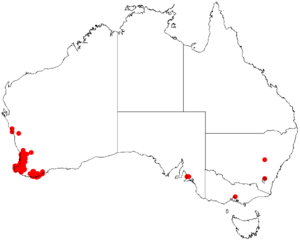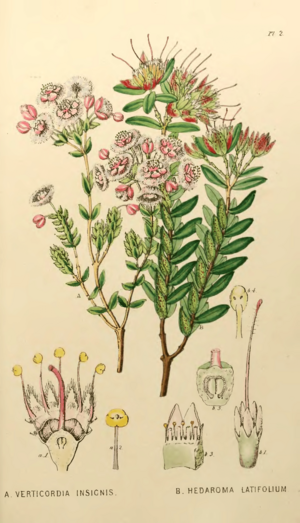Lemon-scented darwinia facts for kids
Quick facts for kids Lemon-scented darwinia |
|
|---|---|
 |
|
| Darwinia citriodora foliage and flowers | |
| Scientific classification | |
| Genus: |
Darwinia
|
| Species: |
citriodora
|
 |
|
| Occurrence data from AVH | |
| Synonyms | |
The Darwinia citriodora, often called the lemon-scented darwinia, is a unique plant from the myrtle family. It grows only in the southwestern part of Western Australia. This plant is a shrub with leaves that look like small spears. It produces beautiful red, yellow, and orange flowers for many months of the year. It's a strong plant that grows well in soil that drains water easily. People often grow it in gardens and sometimes use it to help other plants grow stronger.
Contents
What Does Lemon-Scented Darwinia Look Like?
The lemon-scented darwinia is a neat, rounded shrub. It usually grows to be about 1 to 1.5 meters (3 to 5 feet) tall and wide. Its leaves grow in pairs opposite each other along the stems. Each leaf is about 6 to 12 millimeters (0.2 to 0.5 inches) long. They are shaped like a spear or an oval with a rounded tip, and their edges are slightly curled under.
Most of the time, the leaves are a rich green color. But in winter, they often turn a pretty purplish shade. If you look closely, you can see tiny oil glands on the underside of the leaves. When you crush a leaf, it releases a lovely lemon smell!
The flowers grow in groups of four near the ends of the branches. Each group is surrounded by reddish-green, leaf-like parts called bracts. The individual flowers are small and shaped like a tube. They are yellow, and their petals cover the parts that produce pollen (the stamens). A long, red to yellow stalk, called a style, sticks out about 10 millimeters (0.4 inches) from the flower. Its tip looks like a brush and curves towards the center of the flower group. You can see these flowers blooming between May and December.
How This Plant Got Its Name
This plant was first officially described in 1837 by a scientist named Stefan Endlicher. He gave it the name Genetyllis citriodora. His description was published in a book about plants found in Western Australia.
Later, in 1865, another scientist named George Bentham changed the name to Darwinia citriodora. This change was published in a science journal. The second part of the plant's scientific name, citriodora, comes from two Latin words. Citrea means "lemon," and odora means "smell" or "scent." This perfectly describes the plant's lemony fragrance!
Where Does It Grow?
The lemon-scented darwinia grows in areas close to the coast in Western Australia. You can find it between the Swan River and Cape Riche. It grows in different types of areas, including the Esperance Plains, Jarrah Forest, Swan Coastal Plain, and Warren regions. It prefers to grow in soils that are made of lateritic (red, iron-rich soil) or granitic (soil from granite rock).
Growing Lemon-Scented Darwinia
The Darwinia citriodora has been a popular plant in nurseries for many years. There's even a special type that has bigger flowers than usual! It's quite easy to grow new plants from pieces of the existing plant, called cuttings. The best time to take these cuttings is at the end of summer or in early autumn.
This plant is also very useful as a "rootstock." This means its strong roots can be used to help other, more delicate plants grow. It's especially helpful for plants from the Verticordia, Chamelaucium, and Actinodium groups, as well as other types of Darwinia plants.
Is It Endangered?
Good news! The Government of Western Australia's Department of Parks and Wildlife has listed Darwinia citriodora as "not threatened." This means it's not currently in danger of disappearing.
Images for kids




